B.R. Bates's Blog: From the social feeds ...
October 15, 2025
Benjamin ("Tony") Atkins: The cops who worked the case
They all contributed to the case in their own ways. Each doing his part. Together, they were able to apprehend this serial killer who rampaged Detroit's Woodward Avenue for several months in 1991 and 1992, leaving 11 women dead. In today's post we celebrate several of the law enforcement officers who worked the case of Benjamin ("Tony") Atkins, all of which I have been able to speak with personally for the book, and a few of which we have unfortunately lost in the couple years since then.
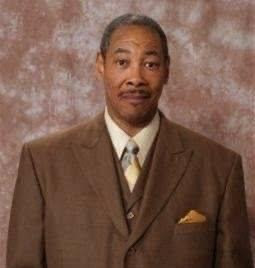
Ron Sanders was the seasoned cop who questioned Atkins for Detroit police shortly after the arrest, and who was able to elicit the confessions from him. Sanders suffered health issues before the January 1994 trial came around and was unable to testify, but he lived decades longer, even penning a book "Concerned But Not Consumed." He passed away in 2023.
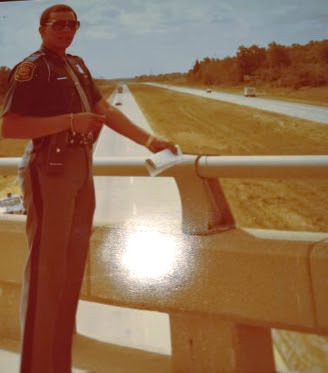
Royce Alston, shown above when he was a trooper for the Michigan State Police, was the officer who took survivor Darlene around the Cass Corridor and Woodward Ave in summer 1992 to try to find the man who had attacked her the previous fall -- a man she knew only as "Tony." Alston has retired to Florida in more recent years.

Jim Dobson, the officer in charge of the case for Highland Park Public Safety, was profiled in this issue of the Sun newspaper in Canada in summer 1992, before Atkins was identified and arrested -- while police were still hunting an unknown killer. You can see Dobson standing at the Monterey Motel (near the story headline). The Sun was the media outlet that coined the term "Crack City Strangler," though the Detroit papers were calling him the Woodward Corridor Killer or Woodward Avenue Strangler. Jim died in late 2023 after a valiant fight with pancreatic cancer.
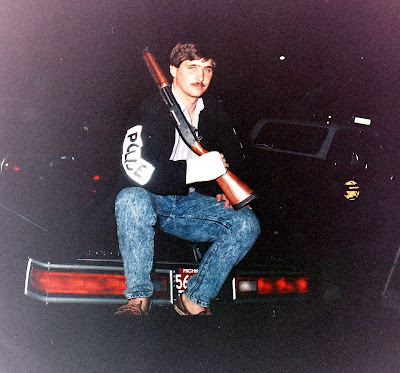
Craig Pulvirenti, above, and below with his work crew back in the day, responded to three of the Atkins crime scenes for Highland Park Public Safety. He went on to a decorated law-enforcement career, also serving in military intel. He still lives in the Detroit area.


Everett Monroe responded to the Patricia Cannon George crime scene for Detroit police. It was the site of a demolished home on Kenilworth Street, and it was a very rainy morning, he recalled. Monroe went on to work the case of another Detroit serial, John Eric Armstrong, a few years later. More recently, he took a police chief post in Georgia.

John Mattox, left, served as the director of Highland Park Public Safety at the time of the Atkins case, went to several of the crime scenes, and was quoted widely in the media at the time. On the right is Larry Beller, one of Mattox's detectives at HPPS, who was instrumental in the search at the Monterey Motel that uncovered three of Atkins' victims in February 1992. I snapped this photo of the two of them on the day of Jim Dobson's funeral in Metro Detroit, early 2024. and I was honored to attend the funeral with them. Larry passed in fall 2024 -- shockingly, as I had just spoken with him a month or two before, and he seemed to be doing great.
These are not all of the brave officers who worked the case, of course, and many more of them have passed in the 30-plus years since Atkins was arrested. This author salutes each and every one of them, and if you know of others, you are welcome to comment below and share stories.
. . . . . . . . . . . . . . . . . . . . . . . . . .

Ron Sanders photo is from his official website. Rest of the photos above are copyrighted and specifically for use with "The Crack City Strangler: The Homicides of Serial Killer Benjamin Atkins." Any other usage is prohibited without permission.
BRBates.com
wbp.bz/CrackCityStrangler
Murders in the Motor City Series
October 10, 2025
Killer Comparisons: Benjamin ("Tony") Atkins and Leslie Allen Williams
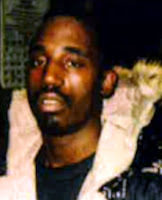 AtkinsThey killed at the same time in the same metro area of Detroit. One preyed on female sex workers of color who used drugs; the other targeted white teen girls for the most part (one was Hispanic). One roamed Woodward Avenue in the inner city, homeless, drug-addicted, and doing sex work himself. The other prowled the northwestern suburbs, more rural areas, and was out on parole in the midst of a criminal career that spanned decades. He was in his later 30s, while the other killer was young -- only 23. One, of course, was black, the other white.
AtkinsThey killed at the same time in the same metro area of Detroit. One preyed on female sex workers of color who used drugs; the other targeted white teen girls for the most part (one was Hispanic). One roamed Woodward Avenue in the inner city, homeless, drug-addicted, and doing sex work himself. The other prowled the northwestern suburbs, more rural areas, and was out on parole in the midst of a criminal career that spanned decades. He was in his later 30s, while the other killer was young -- only 23. One, of course, was black, the other white.But in 1991 and 1992, both of these men terrorized Metro Detroit. Both struck fear in females -- everyone, really -- as police investigated their separate crimes. So how else do they compare?
Williams put some time and planning into his crimes -- he studied young potential victims for a while and cased the neighborhoods where they lived. In fact, his biggest failure occurred when he did not plan, when he encountered survivor Carla at a cemetery, became torqued off at their brief small talk, and decided to kill her without any weapon handy. It did not go well; it was essentially what got him arrested. Atkins did not plan that much -- he let his drug-induced haze guide him along Woodward, taking whatever opportunity popped up as he saw a female on that same historic Detroit ave.
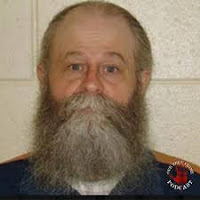 WilliamsWhile Atkins confessed freely a day and a half after his arrest, but then later at trial tried to maintain innocence -- and even used his sentencing statement to say how much this case had hurt him -- Williams showed quite a lot of remorse after his arrest and even said they should lock him up and throw away the key. He also said as much later when appearing on Oprah Winfrey's TV talk show via satellite from prison.
WilliamsWhile Atkins confessed freely a day and a half after his arrest, but then later at trial tried to maintain innocence -- and even used his sentencing statement to say how much this case had hurt him -- Williams showed quite a lot of remorse after his arrest and even said they should lock him up and throw away the key. He also said as much later when appearing on Oprah Winfrey's TV talk show via satellite from prison.There M.O.s varied. Atkins was a strangler only -- often manually, but sometimes with ligature. Williams strangled in three of his four murders, but also stabbed a victim in the chest with a knife, and he used a knife to threaten and subdue in general. He carried a gun with him, too.
Both cases have a necrophilia element. Atkins told police he had sex with his victim's lifeless body in at least one of the 11 murders. Williams said he had sex with his two victims who were teen sisters before he buried their bodies in a shallow grave, though some reports say they were not dead at that point and actually died in the grave (another report says he smothered them before burying them, so that goes to M.O. variance, as well).
Perhaps the most striking comparison between these two killers, however, is their childhoods, which were both marked with trauma, neglect and abuse. Atkins never had a father in the picture; Williams had one who beat him and sexually abused his half-sisters. Atkins had a mother who used heroin, did prostitution, and was largely absent through his upbringing. Williams had a mother who also worked prostitution and was then killed by her third husband. There's no indication of drugs in Williams' background, though, and Atkins' story is marked by a lot of drug use. Both killers as boys spent some time in a group home at which they later claimed to have suffered sexual abuse. A good way to cook a killer? Yes, many would agree.
Above photos:
- Benjamin Atkins, from Detroit Police files, image obtained by FOIA. See this blog post for more on this photo and the confusion over photos of Atkins.
- Leslie Allen Williams photo from Michigan Department of Corrections.
. . . . . . . . . . . . . . . . . . . . . . . . . .

To learn more about the Leslie Allen Williams case, see the episode "The Vanishing Teens," S2E2 of "The Lake Erie Murders." For a deep-dive of the Atkins case, see "The Crack City Strangler: The Homicides of Serial Killer Benjamin Atkins."
BRBates.com
wbp.bz/CrackCityStrangler
Murders in the Motor City Series
October 7, 2025
There will lots of writers gathering "On the River" on November 2 -- check it out!
Authors working in a diverse array of genres -- fantasy, faith, fictionalized memoir, even just-plain fiction and more -- will be assembling for an event hosted by the Monroe County Library System in Michigan. It's Writers on the River, and it happens on Saturday, November 2 in this town south of Detroit. What good company we will be in, my collaborator Dr. Gerald Cliff and I. Check out the lineup on the library's website.
 Sunday, November 2, 2025
Sunday, November 2, 2025From noon – 3 p.m.
Ellis Library & Reference Center | 3700 South Custer Road | 734-241-5277
Also check out the Facebook event for updates in the weeks leading up to it. This promises to be a big event, just from the sheer volume of great authors appearing! Hope to see you there! I will be bringing both books in the #MurdersInTheMotorCity series: "The 'Baby Doll' Serial Killer" and "The Crack City Strangler."

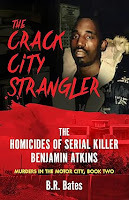
September 29, 2025
Michigan History Author Symposium: Some photos
Michigan history author Michael Delaware hosted an event in Battle Creek this past Saturday to celebrate other authors who write about the past of the Mitten. I was blessed to be one of the featured authors, along with Dr. Gerald Cliff, my collaborator for "The 'Baby Doll' Serial Killer" book. We were two of 12 authors scheduled to speak that day, though one author unfortunately couldn't make it.
I captured some video of my presentation with Dr. Cliff, and you'll see that in the coming weeks on my YouTube channel, but for now, I got some great photos of the event and the other authors speaking there.
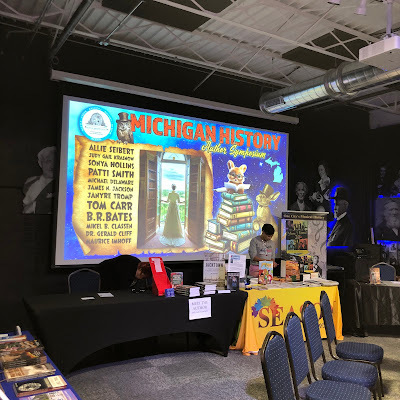
 Allie Siebert, podcaster of "Allie in the Archives" and author of several books on older Michigan murder mysteries
Allie Siebert, podcaster of "Allie in the Archives" and author of several books on older Michigan murder mysteries James N. Jackson, former president of the Detroit Society for Genealogical Research Inc., the Oakland County Genealogical Society, the Calhoun County Genealogical Society
James N. Jackson, former president of the Detroit Society for Genealogical Research Inc., the Oakland County Genealogical Society, the Calhoun County Genealogical Society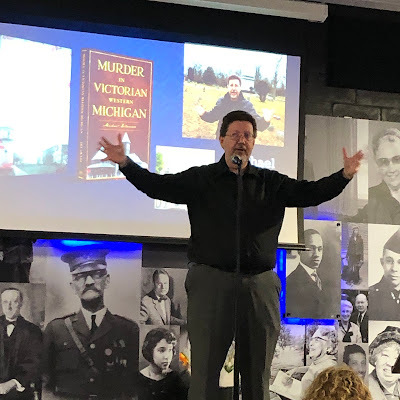 Michael Delaware, organizer of the event who has written a lot of books, notably ones on Michigan true crime of the Victorian era
Michael Delaware, organizer of the event who has written a lot of books, notably ones on Michigan true crime of the Victorian era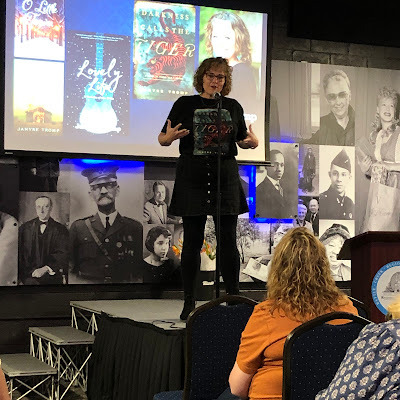 Janyre Tromp, who specializes in mid-20th century historical novels
Janyre Tromp, who specializes in mid-20th century historical novels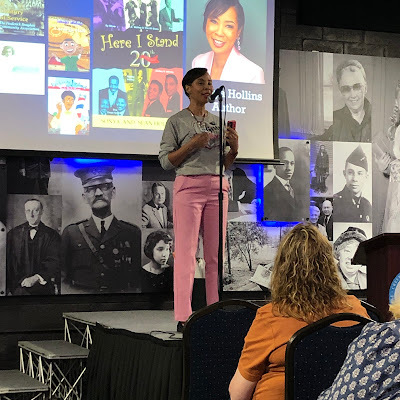 Sonya Bernard Hollins, who has chronicled Battle Creek's music history and who also podcasts
Sonya Bernard Hollins, who has chronicled Battle Creek's music history and who also podcasts 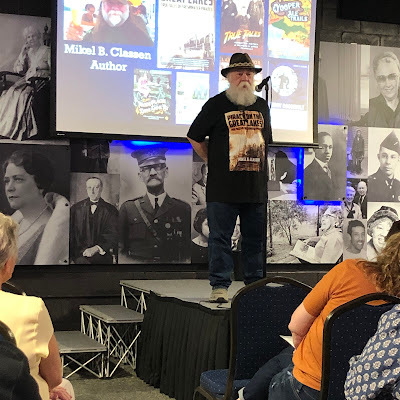 Mikel B. Classen, who has written about "Piracy on the Great Lakes"
Mikel B. Classen, who has written about "Piracy on the Great Lakes"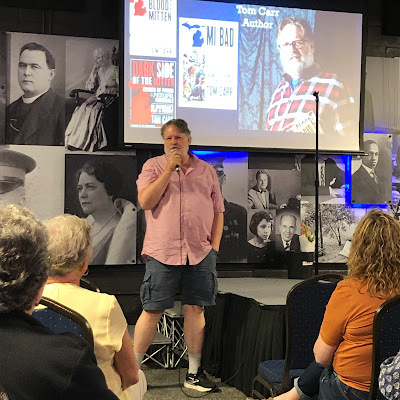 Tom Carr, author of the Blood on the Mitten series
Tom Carr, author of the Blood on the Mitten series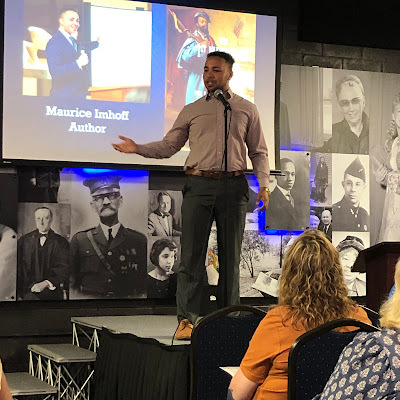 Maurice Imhoff, who chronicled "The 1st Michigan Colored Regiment" of the Civil War
Maurice Imhoff, who chronicled "The 1st Michigan Colored Regiment" of the Civil War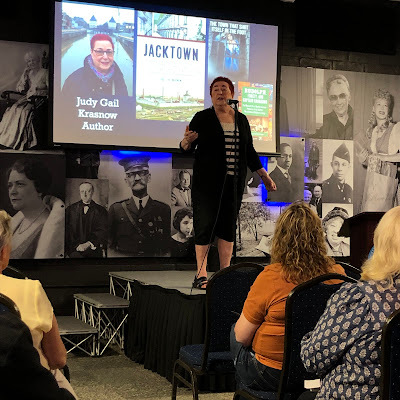 Judy Gail Krasnow, who has documented the history of Jackson's original prison
Judy Gail Krasnow, who has documented the history of Jackson's original prison

Photos by B.R. Bates; copying is OK.
September 26, 2025
Behind the scenes of the Armstrong investigation -- new video series just launched
When Gerry Cliff and I had a chance to speak this past Wednesday evening at the Timothy C. Hauenstein Reynolds Township Library in Howard City, Michigan, Gerry had the chance to give some of the background of the interagency task force that investigated the John Eric Armstrong case. This was the Violent Crime Task Force, and it was formed by the Detroit Police Department but included reps from a variety of law enforcement groups in Michigan. All the stops were being pulled out to catch this killer after three women were discovered at the railroad tracks at Military and John Kronk streets in southwest Detroit in April 10, 2000. This was a highly organized, highly effective task force, and they had their man in a very quick time frame. I'm posting a vid each Friday of Gerry discussing that time -- part 1 just dropped! Stay tuned each Friday for more of the story.
Check it out on YouTube >>>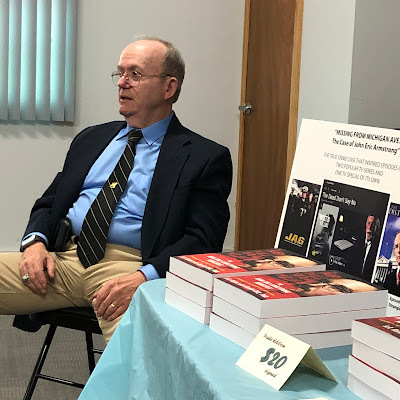
September 25, 2025
We had a nice time at the library in Howard City last night
Thanks so much to Cricket, Cheryl and the crew at the Timothy C. Hauenstein Reynolds Township Library in Howard City, Michigan, for hosting myself and my collaborator, Dr. Gerald Cliff, yesterday evening, to discuss the cases of convicted serial killers John Eric Armstrong and Benjamin ("Tony") Atkins. And thanks to all who came out -- we got some good questions, and it's wonderful to see that the book "The 'Baby Doll' Serial Killer" is carried there at the library.
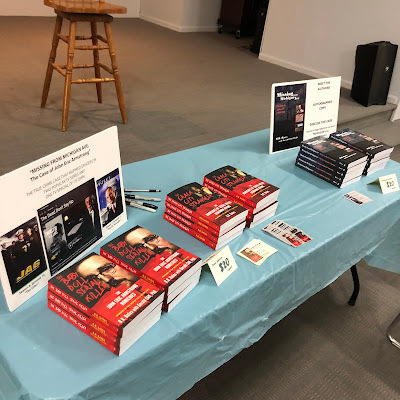

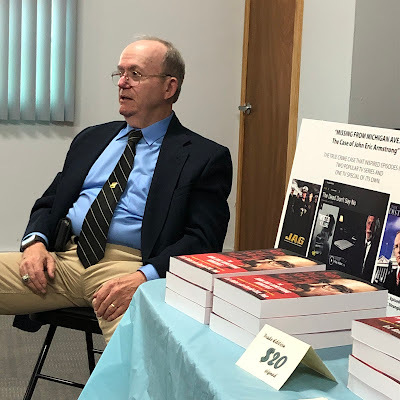
I'll be posting video clips of Gerry's talk on my YouTube channel, so check that out. They'll be dropping on Fridays for the next few weeks. Gerry explained the background of the interagency Violent Crime Task Force that worked the Armstrong case back in 2000, how it came about, and how he came to lead it, then he discussed when the case came on the radar of Detroit Police: The day that three women were discovered at the railroad tracks at Military and John Kronk streets.
Now it's off to the Michigan History Author Symposium at the Battle Creek Regional History Museum this Saturday!
September 22, 2025
Funky Writer interview now up -- listen at your leisure!
 It was a wonderful chat live with Robert Batista of the Funky Writer Show on Saturday afternoon, and that interview is now posted in three spots, where you can listen whenever you feel like it:
It was a wonderful chat live with Robert Batista of the Funky Writer Show on Saturday afternoon, and that interview is now posted in three spots, where you can listen whenever you feel like it:I so appreciate Robert and his great questions. We talked about my true crime work and the Murders in the Motor City books, but we also ventured into my other writing world -- the pop culture area where I write about classic TV shows I grew up with and love. You'll experience both worlds in this latest interview.
Now I'm off this week to do two great author events, Wednesday in Howard City, Michigan, and Saturday in Battle Creek. I hope to see you there!
September 18, 2025
Listen live to this author on the Funky Writer podcast on Saturday
 Robert Batista has been doing his Funky Writer podcast for quite a few years, talking to a diverse array of writers about so many aspects of the writing experience. You can listen to his past episodes on Apple or Spotify, and you can listen live on Podbean. That's where I'll be this Saturday at 4 p.m. Eastern:
Robert Batista has been doing his Funky Writer podcast for quite a few years, talking to a diverse array of writers about so many aspects of the writing experience. You can listen to his past episodes on Apple or Spotify, and you can listen live on Podbean. That's where I'll be this Saturday at 4 p.m. Eastern:You can download the Podbean app on your phone and easily listen in.
September 17, 2025
Two big author signing events coming up next week in Howard City and Battle Creek
Fall is just about upon us (soon to be official, but you know you've been seeing the pumpkin spice whatever all over the stores!!), and we've got two great events coming up next week to make this autumn even sweeter. I will be attending these two with my collaborator, Dr. Gerald Cliff, and we'll be bringing both books in the #MurdersInTheMotorCity series, "The 'Baby Doll'' Serial Killer: The John Eric Armstrong Homicides" and "The Crack City Strangler: The Homicides of Serial Killer Benjamin Atkins."
 Wednesday, September 24, 20256 p.m.Timothy C. Hauenstein Reynolds Township LibraryHoward City, MichiganLearn more >>>
Wednesday, September 24, 20256 p.m.Timothy C. Hauenstein Reynolds Township LibraryHoward City, MichiganLearn more >>>.............................................
 Michigan History Author SymposiumSaturday, September 27, 20251-4 p.m.Battle Creek Regional History Museum307 W Jackson StBattle Creek, MI
Michigan History Author SymposiumSaturday, September 27, 20251-4 p.m.Battle Creek Regional History Museum307 W Jackson StBattle Creek, MI
September 12, 2025
Benjamin ("Tony") Atkins: The jailhouse letters
After his August 1992 arrest in Detroit's Woodward / Cass Corridor, and in the lead-up to his trial that began in January 1994, Benjamin Thomas Atkins, aka Tony, was held in the Wayne County Jail. Besides talks with his attorney, Jeffrey Edison, as they worked on his defense, Atkins was communicating with others. One of those others was the girlfriend of his brother.
Ben had been with his brother -- just one year older -- all of his life. They shared almost all of the same childhood experiences. They were at the same foster homes together, at the same inner-city home for boys together. They were together throughout Ben's childhood, right up until he began to wander the lonely Woodward Avenue in Detroit and Highland Park as an adult, when he went through periods of homelessness. Sometimes he slept at his brother's place for a stretch, but often he crashed at any of the many abandoned buildings dotting the landscape of this desolate urban area. Buildings like the Monterey Motel, where he left three of the women he killed.
So while Ben was always close to his brother, he also became close to his brother's girlfriend. Sometimes she was referred to as his brother's wife -- it's unclear if they were married, but they were together for quite a while (she has since passed on, in more recent years). Ben considered her his sister, and he referred to her that way. The closeness he felt for her is evident when you read the letters below, which he wrote to her during that year and a half he was at the Wayne County Jail.

(The name of Ben's brother's girlfriend is blurred out of these photos by me.)

"Not the Moma." Those of us who were around in the late 1980s / early 1990s -- what does that remind us of? A television show that was popular at the time, perhaps?
 The letter above is the one I call the "Redrum" letter. In it Atkins very interestingly furthered an idea he had been presenting to the various psychologists who were evaluating him in his lead-up to trial. As the months progressed, Atkins began to talk about voices he said he was hearing in his head, distinct people who were living in his head, really. He had been asked about this in his initial interviews with police upon his arrest in August 1992, and he denied hearing any voices. But then, as the four different psychologists / psychiatrists talked with him leading up to his trial, the story began to evolve. First there was one voice, named Tony -- the most malignant and heinous one. Then there were two other voices, females named Mary and Mayolla.
The letter above is the one I call the "Redrum" letter. In it Atkins very interestingly furthered an idea he had been presenting to the various psychologists who were evaluating him in his lead-up to trial. As the months progressed, Atkins began to talk about voices he said he was hearing in his head, distinct people who were living in his head, really. He had been asked about this in his initial interviews with police upon his arrest in August 1992, and he denied hearing any voices. But then, as the four different psychologists / psychiatrists talked with him leading up to his trial, the story began to evolve. First there was one voice, named Tony -- the most malignant and heinous one. Then there were two other voices, females named Mary and Mayolla.It's the Tony voice, or personality, who is reflected in the above letter, the one that Atkins claimed berated him and egged him on to kill the women. In the letter, Tony steps in and writes to Ben's brother's girlfriend in the two blocks of thick black ink -- and this is in backward text. Is this real? Note the detail below, where you can see the backward text written carefully in pencil first, then traced over in the thick black ink. Would a demonic alternate voice or personality need to do that? What do you think? Weigh in on the comments for this post.


In the above letter (with back side below), Atkins elaborates on the torture he said "Tony" was putting him through. Atkins did actually try to hang himself in the jail but was found in time for it to not be fatal. Below, "Tony" steps in and addresses Ben's brother's girlfriend himself, but not with backward text this time. These letters are not dated, so it's not clear which letter was written first. Interestingly, in the paragraph below, "Tony" references one of the other voices / personalities, Mary.

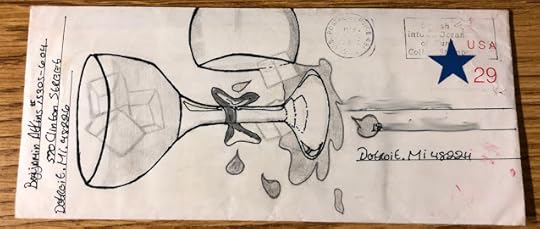
Atkins did apparently like to draw, as show in the envelope for one of the letters.
So are you convinced? Was "Tony" real? I would love your thoughts in the comments section.
In my research for the book, I would crawl into bed with the files at night, giving them an initial read-through before photographing them for my records and further study the next day. When I came upon these yellow-ruled sheets of paper from a legal pad, knowing this killer had once held them in his own hands, it was quite a surreal experience.
. . . . . . . . . . . . . . . . . . . . . . . . . .

For a deep-dive of the Atkins case, see "The Crack City Strangler: The Homicides of Serial Killer Benjamin Atkins."
BRBates.com
wbp.bz/CrackCityStrangler
Murders in the Motor City Series
From the social feeds ...
- B.R. Bates's profile
- 8 followers



